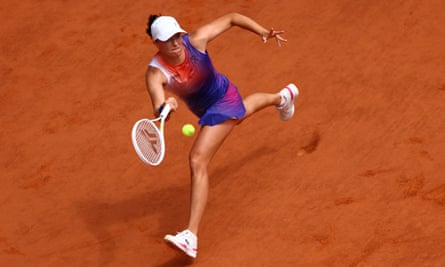In the aftermath of Iga Swiatek’s first grand slam title at the Covid-ravaged autumn Roland Garros in 2020, one of her primary emotions was confusion. Her victory had come so out of the blue, and the rush of attention so overwhelming, that it actually left her with many doubts. Swiatek had to prove to herself more than anyone else that her maiden win was not a “fluke” and she could establish herself as a champion on a consistent basis.
It is fair to say she has done a decent job. On Saturday, Swiatek continued her era of total, relentless dominance over Court Philippe-Chatrier as she completely overwhelmed Jasmine Paolini despite the Italian’s gutsy start, closing out her third consecutive Roland Garros title and fourth overall with an easy 6-2, 6-1 win in 68 minutes.
With another title, the world No 1 continues to build her palmares as a potential great and one of the most successful clay court players of all time. The records are endless: at 23 she is the youngest woman to win a fourth Roland Garros title, two full years younger than Justine Henin, who was previously the youngest. Her record at Roland Garros is now 35-2 (95%). She is also the second woman to sweep the Madrid, Rome and Roland Garros titles after Serena Williams. Somehow, this still feels like the beginning of her story in Paris.
This victory also marks a shift in the overall record books. With five grand slam titles, Swiatek now owns the most majors among regularly active players – seven-time champion Venus Williams only plays occasionally – and she moves level with Maria Sharapova and Martina Hingis on total grand slam titles in the open era. While four of her five titles have come on clay in Paris, Swiatek has won 12 of her 22 career titles on hard courts and next week Swiatek will enjoy her 107th week at No 1. It is only a matter of time before she adds to her count elsewhere.
Considering how Swiatek has dominated the field throughout the second week, it is easy to forget the stress that preceded it. She also joins a select list of players who have won a major title after being one point from defeat, with Swiatek recovering from match point down against Naomi Osaka in their instant classic second round match, which Swiatek won 7-6(1), 1-6, 7-5. In the aftermath of that win, Swiatek was pictured crying in the gym as the stress and tension escaped her. Then she composed herself, set her sights on the rest of the field and never looked back.
Just like in Swiatek’s previous match against Coco Gauff, a dominant opening point from the Pole elicited a shout from the crowd: “Allez Jasmine, c’est pas fini!” (It’s not over), something that may come to be a consistent cheer for opponents over the coming years. But while Swiatek opened with a hold, it was immediately clear that Paolini was trying to approach this impossible task without fear.

In by far the biggest occasion of her blossoming career, Paolini started the match impressively. She refused to give up her position on top the baseline, attacking her heavy forehand without hesitation and constantly trying to put Swiatek under pressure. At times, the Italian practically threw herself into the ball while trying to take it early and impose herself in the match. She immediately settled into her first grand slam final with a hold in her opening service game before breaking for a 2-1 lead.
For a few fleeting moments in this contest, there was a match and the exchanges were actually excellent. At one point, they tussled in a furious 23-stroke rally, with Swiatek moving Paolini from corner to corner, Paolini chasing every last ball, before the Pole finally snapped a crosscourt backhand winner.
after newsletter promotion
The obvious problem for Paolini against Swiatek is that almost everything in Swiatek’s game is performed at a better level. While Paolini’s excellent forehand has driven her to a first major final, Swiatek’s forehand is even heavier and more vicious. She is also a greater athlete and returner, armed with a much better backhand and serve. In the very next service game, Swiatek completely eviscerated her diminutive opponent’s feeble serve, immediately breaking back to love with a backhand return winner and setting the tone for the rest of the match.
As another opponent stepped on the court with no choice but to force themselves out of their comfort zone in the unlikely hope of keeping up, Swiatek was completely comfortable. She flattened Paolini’s serve, her improved serve continued to generate free points and she relentlessly worked the Italian off the court, dominating the rallies until the end. From 1-2 down, Swiatek rolled through 10 games in a row before serving out another Roland Garros title.


